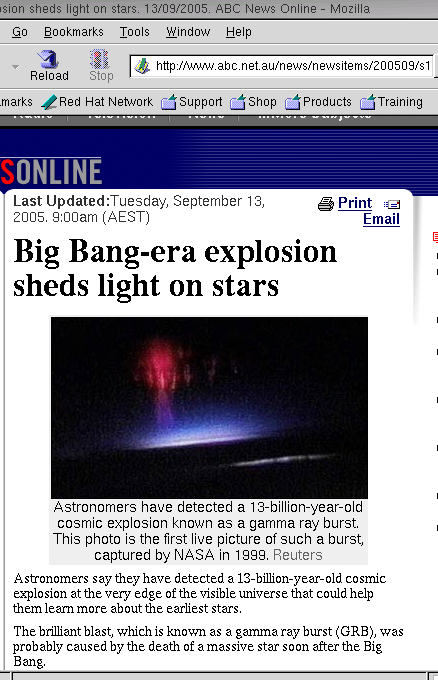

 |
Greg Kochanski |  |
Gamma Ray Bursters [ 1, 2, 3, 4 ] are among the most violent explosions in the universe. An entire star violently disrupts itself, with more energy released even than a supernova. Should one somehow happen within a few light years of Earth, it would be rather unpleasant.
Fortunately, they are extremely rare events, and are thus generally extremely far away. Billions of light years, beyond the solar system, outside our Galaxy, and generally further away than anything else you can see or probably even think of.
Sprites also [ 1, 2, 3, 4, 5 ] are modest electrical discharges that occur high in the upper atmosphere, at altitudes of tens of miles. That's above airplane altitudes, but below satellites; not very far away. Sprites are fairly tenuous things, consisting of humanly-understandable amounts of energy spread out across city-sized volumes of the atmosphere. The total energy content of a sprite is near a gigajoule. That's equivalent to a second's worth of electricity for a city, or the energy content of a thousand jelly doughnuts. Much smaller than the energy of an exploding star.
However, some people are nonetheless confused. In an article
today,  (http://www.abc.net.au/news/newsitems/200509/s1458880.htm)
[fair
use], a photograph of a sprite was passed off as a photo of a
gamma ray burst. It's immediately obvious that it isn't a gamma
ray burster for several reasons:
(http://www.abc.net.au/news/newsitems/200509/s1458880.htm)
[fair
use], a photograph of a sprite was passed off as a photo of a
gamma ray burst. It's immediately obvious that it isn't a gamma
ray burster for several reasons:
Anything that's 12 billion light years away looks like a little dot. Entire galaxies that are only half that far away look like little blurry dots in the best telescopes that we have.
The gamma ray burster has to be fairly small, because the burst comes and goes so fast. If the object was big (say as big as the Sun), then the time it takes light to cross the object would be important.
For instance, if you could somehow explode the Sun instantaneously, you'd see the explosion first in the centre of the disk, because that part is closest to you and the light would get to your eyes first. The edges of the visible disk are further away from your eyes (the sun is a sphere, after all!) and so it would take the flash an extra second or two to get from the edge of the sun to your eye.
So, if the sun flashed, the flash would last for at least a second, just because of the light's travel time difference between the edge and centre. Gamma ray bursters flash faster than that, so they are presumably smaller than the Sun.
So, we're dealing with something much smaller than a galaxy here, and if a galaxy is a dot at that distance, a burster is a microdot.
What the heck is that big dark thing in front of it? It looks like the edge of the Earth.
Now, one can complain about deadlines, or people writing science stories who don't know enough science (and I am complaining), but there's an interesting little twist: Sprites make bursts of gamma rays [ 1, 2, 3 ]. So, the confusion is perhaps a bit understandable. Picture 1 mentions gamma rays, picture 2 mentions gamma rays; picture 1 mentions space, picture 2 mentions space. Understandable or not, though, it's still wrong.
| [ Papers | kochanski.org | Phonetics Lab | Oxford ] | Last Modified Thu Jun 2 19:42:51 2011 | Greg Kochanski: [ Home ] |